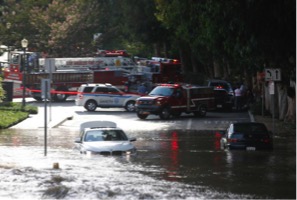The State of U.S. Drinking Water Infrastructure: Challenges and Solutions Since 2013, the American Society of Civil Engineers has given the U.S. drinking water infrastructure a troubling grade of 'D'. Much of our water systems are reaching the end of their useful life, with some pipes dating back over a hundred years. With more than one million miles of water mains across the country, many of these aging systems remain in poor condition, posing serious risks to public health and safety. The Impact
The consequences of failing water infrastructure affect over 264 million Americans who depend on it daily. When large water mains break, it can cause major disruptions in water supply, damage to homes and businesses, and even threaten other essential services. However, the most significant losses occur quietly underground through smaller leaks that go unnoticed for long periods. According to the Water Research Foundation, utilities experience an average of 0.21 to 0.27 breaks per mile of pipeline each year. These incidents not only waste billions of gallons of water but also pose potential health risks if contaminants enter the system. The Cost
Replacing every aging pipe in the U.S. could cost over $1 trillion, according to the American Water Works Association (AWWA). Over the next 25 years, the total cost of expanding and repairing both drinking and wastewater systems could reach $2 trillion. In addition, around 250,000 water mains break annually, with an estimated 2 trillion gallons of water lost due to leaks. A 2012 study from Utah State University found that water utility costs ranged from $6,000 to $7.5 million per incident, with nearly half of these expenses coming from property damage insurance claims. The Funding Gap
A critical issue is the lack of sufficient funding for infrastructure upgrades. From 2008 to 2012, federal appropriations totaled just $6.9 billion—about $1.38 billion per year or $27.6 billion over 20 years. This amount accounts for only 8% of the EPA’s identified needs during the same period. With aging pipes and limited financial support, the U.S. faces a growing water infrastructure crisis that requires immediate attention and long-term planning. Possible Solutions
The Environmental Protection Agency (EPA) is working to improve the sustainability of the nation's water systems. One effective approach is to extend the life of existing infrastructure through rehabilitation rather than full replacement. HJ3 Composite Technologies offers innovative solutions like CarbonSeal, which uses carbon fiber reinforcement to repair and strengthen aging pipes. This technology not only extends the lifespan of pipelines but also reduces costs significantly compared to traditional replacement methods. Importantly, HJ3’s patented system is approved for use in potable water lines, ensuring safety and compliance. If you're dealing with aging or damaged underground pipes and want to explore cost-effective repair options, contact HJ3 to learn more about their advanced CarbonSeal systems. Upgrading your water infrastructure doesn’t have to mean complete replacement—it can be done smarter and more efficiently. Tinplate Cutting Machines,Tinplate Sheet Cutting Machine,Tinplate Sheet Slitting Machine,Tinplate Duplex Cutting Machine Zhoushan Golden Wing Machinery Co., Ltd. , https://www.goldenwingmachines.com

July 12, 2025